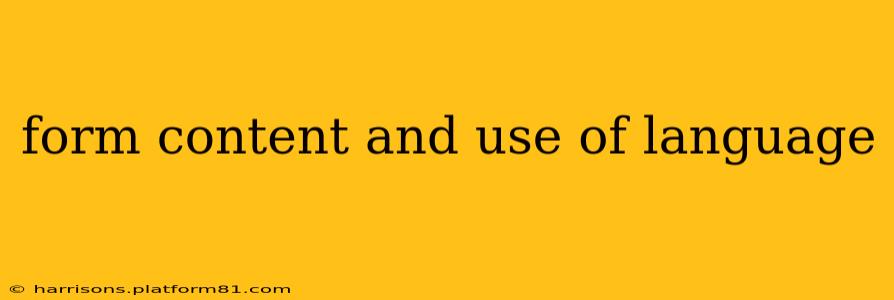Form, Content, and Use of Language: Crafting Compelling Communication
The interplay between form, content, and the use of language is crucial for effective communication. Whether you're writing a novel, a marketing email, or a scientific paper, understanding how these elements work together will determine the impact and success of your message. This exploration delves into the intricacies of each component and how their synergy shapes compelling communication.
What is Form in Communication?
Form refers to the structure and organization of your communication. It encompasses the overall design, layout, and presentation of your message. Think of it as the vessel that carries your content. Examples of form include:
-
Written Communication: This encompasses various forms, from the formal structure of a business report to the informal style of a blog post. Consider factors like paragraph length, sentence structure, use of headings and subheadings, bullet points, and visuals. A well-structured report uses clear headings to guide the reader, while a blog post might employ shorter paragraphs and conversational language to maintain engagement.
-
Visual Communication: This includes presentations, infographics, videos, and images. The visual arrangement and design elements are critical to conveying information effectively. A cluttered presentation can overwhelm the audience, while a well-designed infographic can simplify complex data.
-
Oral Communication: This covers speeches, presentations, and conversations. The structure of your speech, including the introduction, body, and conclusion, as well as your pacing and tone, contribute to the overall form.
Optimizing Form for Impact: The ideal form depends on your audience and your purpose. A formal report will demand a different structure than a casual conversation. Consider:
- Clarity and Conciseness: Ensure your form enhances clarity and doesn't obscure the message.
- Audience Appropriateness: Tailor the form to resonate with your audience's preferences and expectations.
- Accessibility: Make sure your form is accessible to all audiences, considering factors like visual impairments and different reading levels.
What is Content in Communication?
Content refers to the actual information you're conveying. It's the substance, the "what" of your communication. This includes the facts, ideas, opinions, and stories you present. High-quality content is:
- Accurate: Based on factual information and reliable sources.
- Relevant: Addresses the needs and interests of your intended audience.
- Engaging: Captures the attention and interest of your audience.
- Original: Offers a fresh perspective or unique insights.
What is the Use of Language in Communication?
The use of language is how you express your content through words and tone. It encompasses:
-
Word Choice (Diction): Choosing words that are precise, vivid, and appropriate for your audience and purpose. Using formal language in a business proposal differs greatly from using informal language in a text message.
-
Sentence Structure: Varying sentence length and structure to maintain reader interest and clarity. Monotonous sentences can be tiring for the reader.
-
Tone: The overall attitude or feeling conveyed in your communication. A formal tone is appropriate for a scientific paper, while a playful tone might suit a marketing campaign.
-
Style: The distinctive way of writing or speaking, reflecting your personality and approach. A concise and direct style works well for technical writing, while a descriptive style is more suitable for creative writing.
Synergy of Form, Content, and Language:
These three elements are interconnected. Excellent content presented in a poorly designed form will lose its impact. Conversely, a beautifully designed form cannot compensate for weak content or inappropriate language. The use of language must complement both the content and form to create a harmonious and persuasive message.
How to Improve Your Communication Skills
Mastering the synergy of form, content, and language requires continuous effort. Consider:
- Understanding Your Audience: Tailor your communication to your audience's background, knowledge, and expectations.
- Planning and Structuring: Organize your thoughts and ideas before beginning to write or speak.
- Revise and Edit: Proofread your work carefully to ensure clarity, accuracy, and consistency.
- Seek Feedback: Ask others for feedback on your communication to identify areas for improvement.
By understanding and mastering the relationship between form, content, and the use of language, you can create compelling and effective communication that resonates with your audience and achieves your desired outcome.
